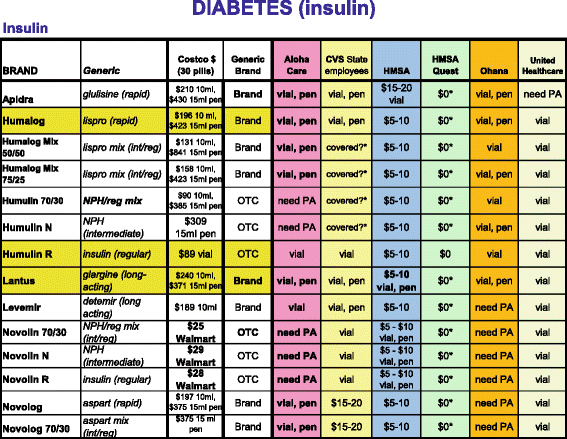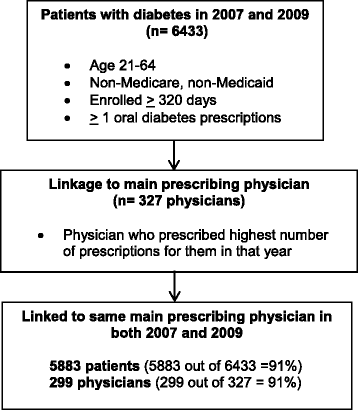Giving formulary and drug cost information to providers and impact on medication cost and use: a longitudinal non-randomized study
- PMID: 27654857
- PMCID: PMC5031286
- DOI: 10.1186/s12913-016-1752-4
Giving formulary and drug cost information to providers and impact on medication cost and use: a longitudinal non-randomized study
Abstract
Background: Providers wish to help patients with prescription costs but often lack drug cost information. We examined whether giving providers formulary and drug cost information was associated with changes in their diabetes patients' drug costs and use. We conducted a longitudinal non-randomized evaluation of the web-based Prescribing Guide ( www.PrescribingGuide.com ), a free resource available to Hawaii's providers since 2006, which summarizes the formularies and copayments of six health plans for drugs to treat 16 common health conditions. All adult primary care physicians in Hawaii were offered the Prescribing Guide, and providers who enrolled received a link to the website and regular hardcopy updates.
Methods: We analyzed prescription claims from a large health plan in Hawaii for 5,883 members with diabetes from 2007 (baseline) to 2009 (follow-up). Patients were linked to 299 "main prescribing" providers, who on average, accounted for >88 % of patients' prescriptions and drug costs. We compared changes in drug costs and use for "study" patients whose main provider enrolled to receive the Prescribing Guide, versus "control" patients whose main provider did not enroll to receive the Prescribing Guide.
Results: In multivariate analyses controlling for provider specialty and clustering of patients by providers, both patient groups experienced similar increases in number of prescriptions (+3.2 vs. +2.7 increase, p = 0.24), and days supply of medications (+141 vs. +129 increase, p = 0.40) averaged across all drugs. Total and out-of-pocket drug costs also increased for both control and study patients. However, control patients showed higher increases in yearly total drug costs of $208 per patient (+$792 vs. +$584 increase, p = 0.02) and in 30-day supply costs (+$9.40 vs. +$6.08 increase, p = 0.03). Both groups experienced similar changes in yearly out-of-pocket costs (+$41 vs + $31 increase, p = 0.36) and per 30-day supply (-$0.23 vs. -$0.19 decrease, p = 0.996).
Conclusion: Giving formulary and drug cost information to providers was associated with lower increases in total drug costs but not with lower out-of-pocket costs or greater medication use. Insurers and health information technology businesses should continue to increase providers' access to formulary and drug cost information at the point of care.
Keywords: Electronic prescribing; Formularies; Medication use; Out-of-pocket cost; Prescription drug costs.
Figures


Similar articles
-
Physicians' opinions about responsibility for patient out-of-pocket costs and formulary prescribing in two Midwestern states.J Manag Care Pharm. 2008 Oct;14(8):780-9. doi: 10.18553/jmcp.2008.14.8.780. J Manag Care Pharm. 2008. PMID: 18983207 Free PMC article.
-
Impact of a transition to more restrictive drug formulary on therapy discontinuation and medication adherence.J Clin Pharm Ther. 2016 Feb;41(1):64-9. doi: 10.1111/jcpt.12349. Epub 2016 Jan 18. J Clin Pharm Ther. 2016. PMID: 26778812
-
Brand Medications and Medicare Part D: How Eye Care Providers' Prescribing Patterns Influence Costs.Ophthalmology. 2018 Mar;125(3):332-339. doi: 10.1016/j.ophtha.2017.05.024. Epub 2017 Jun 16. Ophthalmology. 2018. PMID: 28625684 Free PMC article.
-
Effect of electronic prescribing with formulary decision support on medication tier, copayments, and adherence.BMC Med Inform Decis Mak. 2014 Aug 28;14:79. doi: 10.1186/1472-6947-14-79. BMC Med Inform Decis Mak. 2014. PMID: 25167807 Free PMC article.
-
Where Do Real-Time Prescription Benefit Tools Fit in the Landscape of High US Prescription Medication Costs? A Narrative Review.J Gen Intern Med. 2023 Mar;38(4):1038-1045. doi: 10.1007/s11606-022-07945-z. Epub 2022 Nov 28. J Gen Intern Med. 2023. PMID: 36441366 Free PMC article. Review.
Cited by
-
Health informatics interventions to minimize out-of-pocket medication costs for patients: what providers want.JAMIA Open. 2022 Feb 24;5(1):ooac007. doi: 10.1093/jamiaopen/ooac007. eCollection 2022 Apr. JAMIA Open. 2022. PMID: 35274083 Free PMC article.
-
Clinicians' Values and Preferences for Medication Adherence and Cost Clinical Decision Support in Primary Care: A Qualitative Study.Appl Clin Inform. 2020 May;11(3):405-414. doi: 10.1055/s-0040-1712467. Epub 2020 Jun 3. Appl Clin Inform. 2020. PMID: 32492717 Free PMC article.
-
"It's a mess sometimes": patient perspectives on provider responses to healthcare costs, and how informatics interventions can help support cost-sensitive care decisions.J Am Med Inform Assoc. 2022 May 11;29(6):1029-1039. doi: 10.1093/jamia/ocac010. J Am Med Inform Assoc. 2022. PMID: 35182148 Free PMC article.
-
What is in your wallet? A cluster randomized trial of the effects of showing comparative patient out-of-pocket costs on primary care prescribing for uncomplicated hypertension.Implement Sci. 2018 Jan 10;13(1):7. doi: 10.1186/s13012-017-0701-x. Implement Sci. 2018. PMID: 29321043 Free PMC article. Clinical Trial.
-
Formulary Management Activities and Practice Implications Among Public Sector Hospital Pharmaceutical and Therapeutics Committees in a South African Province.Front Pharmacol. 2020 Aug 18;11:1267. doi: 10.3389/fphar.2020.01267. eCollection 2020. Front Pharmacol. 2020. PMID: 32973508 Free PMC article.
References
-
- Visualizing health policy: recent trends in prescription drug costs. Kaiser Family Foundation. April 5, 2016. http://kff.org/infographic/visualizing-health-policy-recent-trends-in-pr.... Accessed 22 Aug 2016.
-
- Hoadley J, Cubanski J, Neuman T. Medicare Part D in 2016 and trends over time. Kaiser Family Foundation. Sep 16, 2016. http://kff.org/medicare/report/medicare-part-d-in-2016-and-trends-over-t.... Accessed 19 Sep 2016.
-
- It pays to shop: variation in out-of-pocket costs for Medicare Part D enrollees in 2016. Kaiser Family Foundation; 2015. http://kff.org/medicare/issue-brief/it-pays-to-shop-variation-in-out-of-.... Accessed 22 Aug 2016.
Grants and funding
LinkOut - more resources
Full Text Sources
Other Literature Sources

